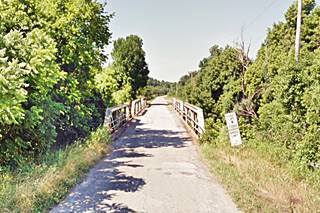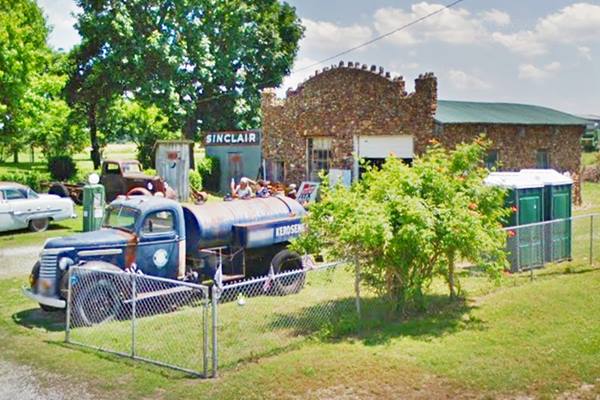
Where the Road Remembers: The Enduring Charm of Paris Springs, Missouri
Deep in the verdant embrace of the Missouri Ozarks, where the asphalt ribbons of history and modernity intertwine, lies a place that refuses to be forgotten. Paris Springs, Missouri, is less a town and more a whisper from the past, a living, breathing postcard from an era when the journey was as important as the destination. It is a testament to resilience, nostalgia, and the enduring power of the open road, a quiet sentinel guarding the sepia-toned memories of America’s Mother Road, Route 66.
To stumble upon Paris Springs today is to step out of time. The roar of Interstate 44, a mere stone’s throw away, fades into a distant hum, replaced by the gentle rustle of leaves and the distant chirping of crickets. What remains of Paris Springs is not a bustling metropolis, nor even a sleepy village with a post office and general store. Instead, it is a meticulously preserved fragment, a curated experience centered around one iconic landmark: the Gay Parita Sinclair station.
This isn’t merely a gas station; it’s a shrine, a museum, and a vibrant community hub all rolled into one. Rebuilt with painstaking care and boundless passion by the late Gary Turner, the Gay Parita Sinclair station stands as a beacon for Route 66 enthusiasts, history buffs, and casual travelers alike. Gary, a legendary figure among Mother Road aficionados, dedicated years of his life to resurrecting this 1930s-era station from scratch, turning a desolate stretch of road into a living monument. He famously said, "I’m not selling gas; I’m selling memories." And indeed, memories are what visitors take away in abundance.

The station itself is a marvel of authentic restoration. Vintage gas pumps, their glass globes gleaming, stand proudly at attention. The small, white-painted building, adorned with the iconic green Sinclair dinosaur logo, is packed to the rafters with an eclectic array of Route 66 memorabilia: old license plates, maps, postcards, signs, and a delightful clutter of Americana. A classic Ford Model A or a vintage Harley Davidson might often be parked outside, adding to the perfect photographic tableau. Visitors are encouraged to explore, to touch, to reminisce, and to sign the guestbook, which bears signatures from every corner of the globe.
Paris Springs’ story is inextricably linked to the rise and fall of Route 66. Before the Mother Road, the area was known for its natural springs, a welcome source of fresh water for weary travelers and early settlers. These calcium-rich waters, bubbling up from the Ozark bedrock, gave the locale its name and offered a brief respite in the challenging journey across Missouri. When Route 66 was commissioned in 1926, carving its way from Chicago to Los Angeles, Paris Springs found itself perfectly positioned along one of America’s most celebrated arteries.
The tiny settlement blossomed. Motels, diners, and a smattering of service stations sprung up to cater to the endless stream of automobiles. Families embarking on cross-country adventures, "Okies" fleeing the Dust Bowl, and soldiers returning from war all passed through, leaving their fleeting impressions on the landscape. Paris Springs became a quintessential roadside stop, a place where one could refuel both car and spirit before continuing the westward migration or the eastward return. The cacophony of engine noise, the laughter of children, and the clatter of plates from roadside eateries would have filled the air, painting a vivid picture of a vibrant, if small, community thriving on the pulse of American travel.
However, the very progress that birthed Route 66 also heralded its decline. The advent of the Interstate Highway System in the mid-20th century, particularly the construction of Interstate 44 in the 1960s, sounded a death knell for many of these small towns. Designed for speed and efficiency, the interstates bypassed the slower, meandering paths of Route 66, leaving once-thriving communities like Paris Springs stranded. Businesses shuttered, buildings crumbled, and the lively atmosphere gave way to an eerie silence. Paris Springs, like so many other "ghost towns" along the Mother Road, faded into obscurity, its purpose seemingly rendered obsolete.
It was into this desolation that Gary Turner stepped. Recognizing the profound historical and cultural significance of Route 66, he envisioned not just a restoration, but a revival. He purchased the land where the original Gay Parita Sinclair station once stood and, guided by old photographs and an unwavering dedication, painstakingly rebuilt it. He wasn’t just recreating a structure; he was resurrecting a spirit. Gary, with his infectious enthusiasm and genuine warmth, transformed Gay Parita into more than a stop; it became a destination in itself, a focal point for the preservation movement that sought to reclaim and celebrate the forgotten segments of Route 66.
The influence of Gay Parita and Paris Springs extends beyond the historical. Many visitors, especially those with an eye for animated films, immediately recognize a striking resemblance between Gay Parita and the fictional "Radiator Springs" from Disney-Pixar’s beloved movie Cars. The film, which tells the story of a hotshot race car who learns the value of small-town life after getting stranded on the forgotten Route 66, drew heavily from real-life inspirations along the Mother Road. While no official confirmation ties Gay Parita directly to the film’s animators, the parallels are undeniable, adding another layer of whimsical charm and attracting a new generation of travelers to this historic site. Gary Turner himself often embraced the comparison, delighting in the wonder it brought to children and adults alike.
Beyond the iconic station, the "town" of Paris Springs offers subtle clues to its past. Faint foundations of old buildings, overgrown by decades of nature’s reclamation, hint at what once was. An old stone bridge, still bearing the scars of countless passing vehicles, spans a small creek, a quiet witness to the ebb and flow of history. The original springs, though perhaps less prominent now, continue to flow, a constant reminder of the natural resource that first drew people to this spot. These silent sentinels, coupled with the meticulously restored station, create an immersive experience, inviting visitors to piece together the narrative of a place that refused to truly die.
The preservation of places like Paris Springs is crucial not just for historical accuracy, but for cultural memory. Route 66 represents a formative chapter in the American story – a narrative of migration, economic boom, technological advancement, and the enduring allure of freedom on the open road. It embodies the spirit of adventure, resilience, and community that defines much of the American character. Paris Springs, through the dedication of individuals like Gary Turner and the continued efforts of those who maintain Gay Parita today, keeps that narrative alive. It serves as a tangible link to a bygone era, allowing present-day travelers to physically connect with the stories and experiences of their predecessors.

In a world increasingly driven by speed and efficiency, Paris Springs offers a much-needed antidote: a pause, a moment for reflection, a chance to slow down and appreciate the journey itself. It reminds us that sometimes, the most profound experiences are found not on the superhighways, but on the winding, forgotten roads where every mile tells a story. It’s a place where the past isn’t just observed; it’s felt, breathed, and cherished.
Today, Paris Springs, Missouri, continues to welcome visitors from across the globe. They come to photograph the station, to share stories, to sign the guestbook, and to simply bask in the atmosphere of a place that time forgot, only to be lovingly remembered. It’s a pilgrimage for some, a curious detour for others, but for everyone who stops, it offers a glimpse into the soul of America’s Mother Road. Paris Springs may be small, but its spirit is immense, a vibrant, enduring testament to the magic of Route 66 and the people who keep its memory alive, one memory at a time. It stands as a quiet, yet powerful, reminder that some roads, even when bypassed, never truly fade away. They simply wait for those who are willing to look a little closer, and listen a little harder, for the whispers of the past.


